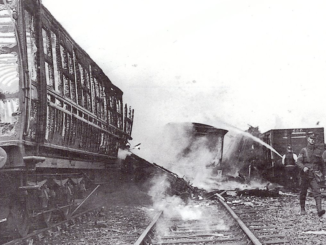Art and the terminal
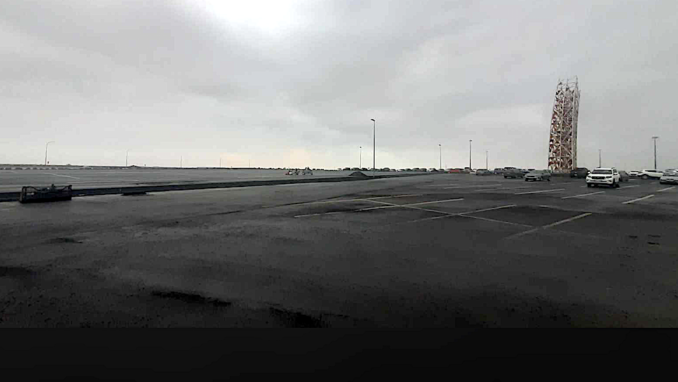
© Always Worth Saying 2024, Going Postal
Puffins who can see an enviably empty airport car park in the middle of nowhere with the skeleton of a nosedived B-52 embedded in the tarmac embarrassingly far from any runway, are Philistines.
Pictured to the right is the Regnbogi, a significant work by Icelandic artist Rúrí. Standing 24 meters high, this is the tallest artwork in Iceland and is made of square-shaped stainless-steel tubes and stained glass. Puffins with mild autism will already have spotted that the colours of the rainbow are represented and will have counted the 313 yellow, red, green and blue coloured units which create a ‘striking visual effect’.
This sculpture is not only an artistic representation of a rainbow but also alludes to the movements and interactions of people within an airport, symbolizing the welcome and farewells that occur as part of the travel experience. It will even look like a rainbow if the sun ever shines.
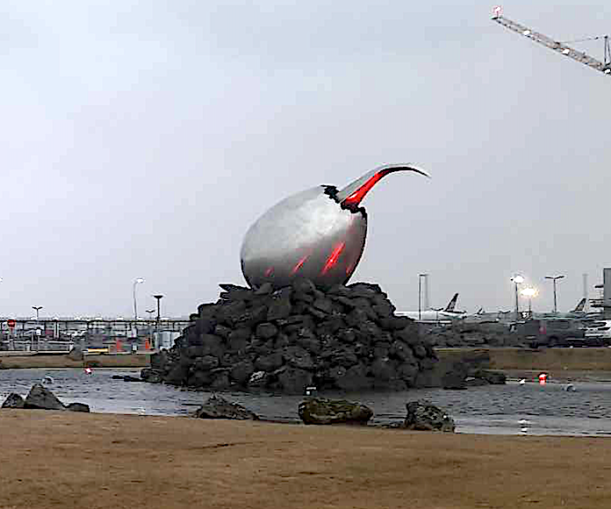
© Always Worth Saying 2024, Going Postal
Likewise, readers who spot a ‘plug and gun’ broken arrow fallen from a B-29 fortuitously landed on a heap of soft volcanic rock in the middle of an outsized puddle during the 1950s, are showing their ignorance. Above is pictured the Þotuhreiður which, as every Puffin knows, is Icelandic for ‘jet nest’. You don’t need this reviewer of photos, and teller of tall tales, to tell you this is a Magnús Tómasson sculpture.
Resembling the tip of an aircraft wing emerging from an egg, it symbolises the birth or genesis of flight. The metal structure is a prominent feature capturing the dynamic nature of aviation and the role of airport as gateway to country. Oh yes.
‘Directions’ by Steinunn Thorarinsdottir is another piece located outside the terminal building of Iceland’s Keflavik entree point. Struggling to spot it, according to the guff, Thorarinsdottir’s work explores the human figure and themes of travel and transition. It contributes to the aesthetic and cultural atmosphere of Keflavík International while offering travellers a moment of reflection and an artistic introduction to Iceland. Is it the crane?
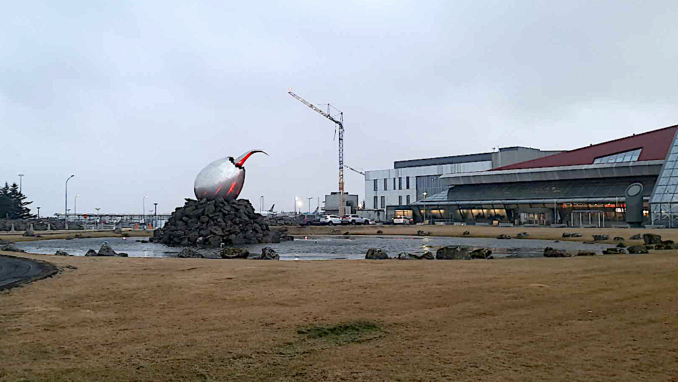
© Always Worth Saying 2024, Going Postal
In among the ‘art’ sits the Leifur Eiríksson Air Terminal, named after the famous Icelandic explorer credited as the first European to set foot in America. Opened in April 1987, the terminal marked a pivotal landmark in local aviation as it separated the airport’s civil traffic from the adjoining military base.
In 2001, the South Building was added to comply with the requirements of the Schengen Agreement, which allows for passport-free travel between many European countries. Later, the North Building was expanded and completed in 2007, enhancing its capacity and facilities.
Outside, the airport features two intersecting runways, 1/19 and 10/28, which are used for both commercial and cargo flights. These are long and wide enough to accommodate a variety of aircraft, including wide-body jets operating on long-haul international routes. The airport’s apron areas provide ample space for parking and servicing.
Additionally, remnants of the airport’s military past is still evident in its layout. The area once occupied by the U.S. military is separate from the non-military aviation facilities, reflecting the dual-use nature of Keflavík Airport during the Cold War. As the military’s presence has decreased since the base’s closure in 2006, some of these facilities have been repurposed for other uses, including aviation-related businesses and the Icelandic Coast Guard.

Aerial photograph of Keflavík International Airport,
Superjet International – Licence CC BY-SA 2.0
Wartime Meeks Field
As we discovered last time, the history of international airports began in Iceland during the Second World War. A British invasion in 1940 set up several RAF bases, some using runways, some using fjords and seaplanes.
America entered the war in December 1940 and in 1941 the United States built Keflavík as part of a defence agreement with Iceland. The airport was first called Meeks Field, named after George Meeks, a pilot who died in a plane crash during the building of the airfield.
Construction was carried out by the US Army Corps of Engineers. The site chosen was a flat expanse near the town of Keflavík, an area conducive to building runways to accommodate heavy, long-range aircraft. The work involved building two runways, taxiways, and the necessary support facilities.
When operational, it served as a key refuelling and transit point for American aircraft as well as a base for anti-submarine patrol aircraft hunting for U-boats. The strategic position allowed for effective control over the critical GIUK (Greenland-Iceland-United Kingdom) gap, which was essential in maintaining the integrity of Allied shipping routes.
After the war, with the threat of German submarines eliminated, the airfield’s importance diminished. However, its location remained of use to the military. In August 1948 the newspapers reported of six RAF Vampire jets returning from a goodwill million to America which were delayed at Meek’s Field by the weather.
Being led by a Mosquito ‘pathfinder’, they left Iceland at 9:20 am anticipating a 90-minute ocean flight to Stornoway but 20 minutes after takeoff weather along the route appeared to be deteriorating. The formation returned to Meeks Field in anticipation of another attempt the following day. More testing times for navigators and meteorologists!
The Cold War
With the onset of the stand-off with the Warsaw Pact, in 1951 the USA and Iceland signed an agreement allowing America to return to establish a military base, re-named as Naval Air Station Keflavik, for NATO operations. This base played a crucial role in monitoring Soviet submarine and aircraft activity in the North Atlantic.
NAS Keflavík became a strategic point for monitoring Soviet military activities. While many of the specific missions conducted from Keflavík remain classified, some general aspects of the operations carried out there are known.
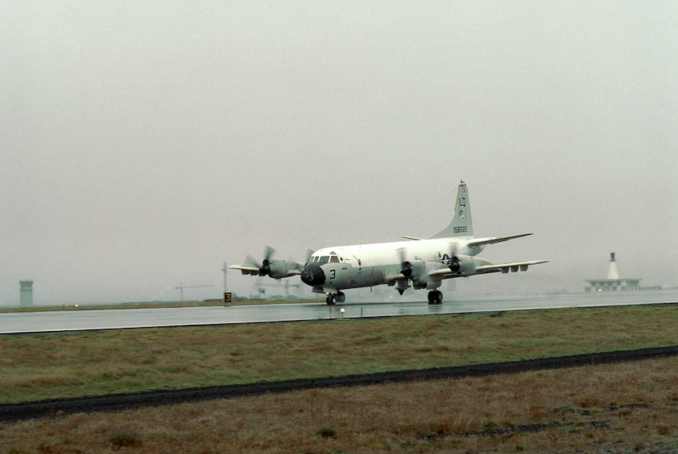
U.S. Navy Lockheed P-3C-115-LO Orion,
US Navy – Public domain
One of the primary roles of the forces based at Keflavík was anti-submarine warfare. This was a crucial theatre for NATO during the Cold War due to the presence of submarines which could launch ballistic missiles at North America or Europe. Aircraft stationed at Keflavík would patrol the surrounding strategic naval chokepoint, to detect and track submarines.
In addition to hunting submarines, aircraft from Keflavík were involved in broader maritime reconnaissance. This included tracking Soviet surface vessels, particularly the Northern Fleet when it moved in and out of Murmansk, Leningrad or the Kola Peninsular. Reconnaissance flights were important for NATO intelligence-gathering efforts, keeping tabs on naval movements and capabilities.
Keflavík was also a significant site for signal intelligence operations. Aircraft equipped with sophisticated sensors would intercept and analyze military communications, radar signals and other electronic emissions. This information was critical for understanding Soviet operational patterns and technological developments.
In the late 1950s, Keflavik was mooted as part of a television link across the Atlantic. Nowhere along the trans-oceanic Great Circle route familiar to airmen is more than 300 miles between land masses. Strangled at birth by newly emerging satellite communications, masts on Newfoundland, Greenland, Iceland, the Faroe Islands and Scotland were anticipated to pass television images between the United States and Europe.
Cold Warriors
The IDF (not that IDF, the Iceland Defence Force) was also established in 1951. Primarily composed of American military personnel, the IDF was responsible for defending Iceland and ensuring the security of operations at Keflavík. The IDF was a critical component in NATO’s Cold War strategy, as it maintained readiness to counter any potential aggression.
Units stationed there included the 57th Fighter Interceptor Squadron (57 FIS) also known as the Black Knights of Keflavik. They operated F-4 Phantom IIs and later F-15C and F-15D Eagles. The 57th was responsible for intercepting aircraft approaching NATO airspace.
The 85th Group was responsible for various aspects of base operation and defence. 932d Air Control Squadron was in charge of the Radar Operations Control Center at Keflavik, which coordinated interceptors to contacts passing through the GIUK gap. It also managed the AN/FPS-117v5 radar at Keflavik Air Station.
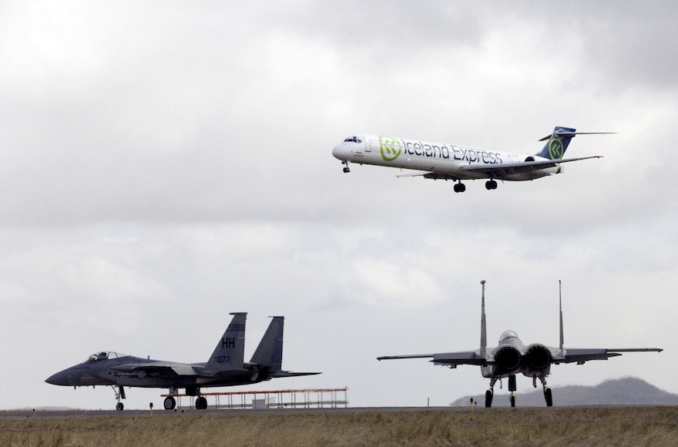
MD-90 approaching Keflavik with F-15s, 2006,
US Air Force – Public domain CC BY-SA 2.0
In the modern day
While the specific details and outcomes of many missions from Keflavík during the Cold War remain under wraps, it is clear the base played an important part in the broader strategy of deterrence and surveillance against the Soviet threat. With the end of the Cold War and the departure of the U.S. military in 2006, the focus of Keflavík Airport shifted to civil aviation. Having said that, an expeditionary wing of Lakenheath F-15s maintains a NATO presence if needs be.
In the modern day and according to more guff, Keflavik serves as a central hub for a substantial network of flight routes, connecting passengers to a wide selection of destinations. Twenty-eight airlines operate collectively to 91 different destinations.
The airport hosts approximately 307 scheduled take-offs each week. Icelandair is notably the largest operator. Other significant carriers include Star Air and easyJet.
Equipped to handle various aircraft types, the Boeing 737 and the Airbus A31X/32X are the most common. The airport also accommodates larger aircraft such as the Boeing 767 and Boeing 757. These aircraft facilitate both short and long-haul flights, with the longest scheduled flight from Keflavik being to Punta Cana, which takes around 8 hours and 30 minutes.
The top destinations served include major European cities like Copenhagen, Manchester, Amsterdam (Schiphol), London (Heathrow), Paris (Charles De Gaulle) and other global destinations. The airport’s strong network and variety of airlines make it a pivotal point for travel to and from Iceland.
Catering to both leisure and business travellers via a perhaps surprising variety of direct flights and connections (thanks to being on the Great Circle route), Keflavik also caters to Puffins on a peace mission to the White House needing an unexpected entry point to the US. Speaking of which, Punta Cana is in the Dominican Republic, slap bang in the middle of the Caribbean Sea. I wonder…
To be continued…
© Always Worth Saying 2024



